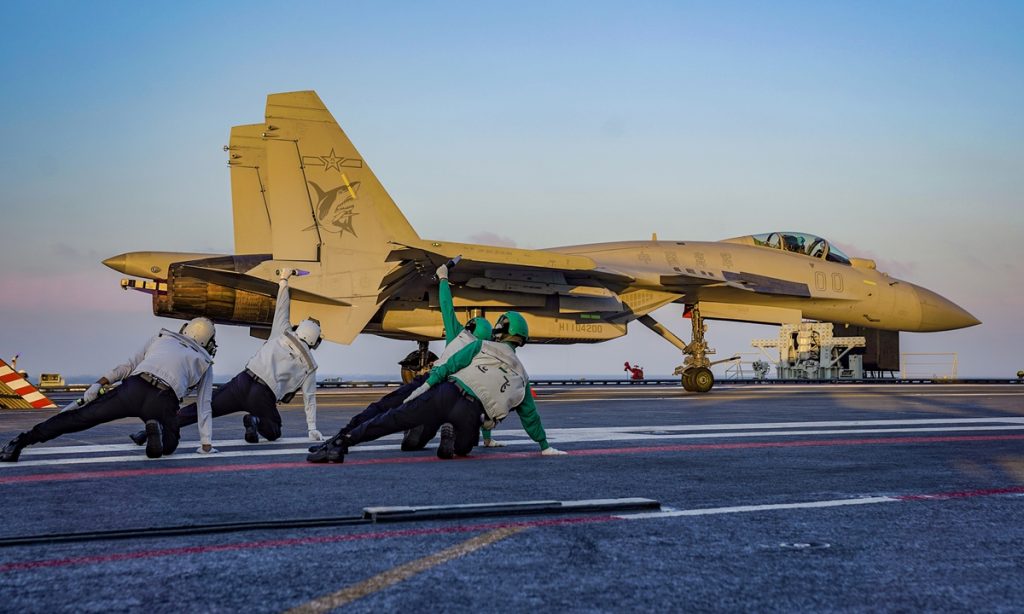China's aircraft carrier Shandong hosted nearly 10,000 sorties of aircraft in five years since commissioning: official media

Multiple Chinese official media on Thursday published stories about the takeoff and landing support squadron on board China's first domestically built aircraft carrier, the Shandong. The reports revealed for the first time that the squadron has ensured the safe takeoff and landing of nearly 10,000 sorties of various types of carrier-based aircraft since the Shandong's commissioning five years ago, continuously increasing carrier-borne aircraft's sortie rate.
A Chinese military affairs expert told the Global Times on Thursday that the squadron's achievements reflect the Shandong's growing overall combat capability, demonstrating that it is fully capable of undertaking far seas defense operations and effectively responding to external challenges.
The official media stories highlighted how the officers and sailors of the Shandong's takeoff and landing support squadron have deeply committed themselves to the frontline of operational support, pooling their wisdom to tackle technical challenges and continuously pushing and breaking through the limits of the aircraft carrier's combat capabilities.
The aircraft carrier Shandong was officially commissioned into the People's Liberation Army (PLA) Navy on December 17, 2019. From the first landing and takeoff of the J-15 fighter jet on aircraft carrier Liaoning on November 23, 2012, to the continuous breakthroughs in the maximum consecutive sorties of carrier-based aircraft, the officers and sailors of the takeoff and landing support squadron of the Shandong have been both witnesses to and makers of history.
Carrier-borne aircraft serve as the spearhead of an aircraft carrier's combat capability, while their sortie rate determines the sharpness and strength of this cutting edge. As the critical link between the aircraft and the carrier, this squadron plays an indispensable role in unleashing the ship's full combat potential. Through analyzing patterns from tens of thousands of training sessions and refining support procedures across thousands of sorties, the squadron has mastered the ability to simultaneously ensure safe takeoffs and landings for multiple types of carrier-based aircraft within tight timeframes, according to China Bugle, an official media account affiliated with the PLA news media center.
China Bugle highlighted in its report that the J-15 fighter jet now operates at increasingly faster speeds, larger scales, higher frequencies, and exponentially improved sortie rates.
Chinese military affairs expert Zhang Junshe told the Global Times on Thursday that the increasing launch speed of carrier-based aircraft demonstrates that the Shandong carrier's air wing has achieved seamless integration of ship, aircraft, and personnel, marking a further enhancement of the carrier group's systematic combat capabilities. In wartime scenarios, faster carrier-based aircraft launch speeds mean shorter response times for fighters to scramble and engage, and this inherently boosts the combat effectiveness of the entire carrier group, he said.
A story by the PLA Navy's official social media account provided another detail: during the recent far seas dual-carrier group training mission, the Shandong swiftly scrambled fighter jets under the support of the squadron to deal with a foreign military aircraft attempting close-range harassment, prompting the foreign aircraft to retreat after recognizing the Chinese response.
China Central Television's (CCTV) military channel also mentioned that during the training, foreign vessels and aircraft repeatedly conducted close-in reconnaissance and tracking surveillance. On one late-night occasion, the squadron successfully carried out carrier-based fighter jet launch operations, handling the situation with professional competence. A crew member aboard the carrier said that, "We maintain all-weather response capabilities. No matter the circumstances, if you dare approach, we have the ability to launch aircraft and respond."
Zhang said that the rapid launch and response capability of the Shandong's fighter jets against unidentified aerial targets demonstrates the carrier group's robust combat readiness and emergency response proficiency. This performance confirms that the command crew, pilots, and aircraft have passed rigorous operational tests, achieving deeper ship-aircraft-personnel integration, fully meeting the demands of maritime warfare, contingency operations, and emergency combat scenarios.
He further noted that these flight operations represent all-weather capabilities, including night operations and adverse weather condition sorties. This reflects substantial improvements in the carrier group's reconnaissance, early warning, command-and-control systems, as well as emergency combat capacity. The carrier's air wing has achieved full all-weather operational capability, marking continuous enhancement of the carrier's comprehensive combat capability, now fully qualified for far seas defense missions.
New benchmark
The official reports also mentioned that the takeoff and landing support squadron of the carrier Shandong has ensured the safe operations of nearly 10,000 sorties involving multiple types of carrier-based aircraft, achieving consistent growth in sortie rates and continuously setting new records for the combat capability benchmarks of China's aircraft carriers.
These types of aircraft include the J-15 fighter jet, the newly unveiled J-15T catapult-launch variant, search and rescue helicopter, early warning helicopter and transport helicopter, which have conducted maritime missions together with the carrier, Zhang said.
Zhang believes it is not unexpected that the Shandong has hosted nearly 10,000 sorties of safe aircraft takeoff and landing operations. It also demonstrated the carrier's combat capabilities.
The Japanese Maritime Self-Defense Force tracked the Shandong carrier group when it carried out training in the Western Pacific waters in July last year. Citing the Japanese data, Zhang said that the Shandong completed 380 aircraft sorties in seven days, or 54.3 sorties per day on average. These included 240 J-15 sorties and 140 helicopter sorties. This exceptional operational tempo meets the requirements for medium-to-high intensity regional maritime warfare, the expert said.